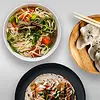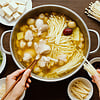Cornstarch, a powdery staple derived from corn grain, is a quintessential ingredient in kitchens around the globe, but it finds a particularly significant place in Chinese cooking. Esteemed for its versatility, cornstarch is not just a thickener; it's a culinary transformer that enhances texture, adds gloss to sauces, and creates that sought-after silky mouthfeel in soups and stir-fries. In this long-form blog post, we'll explore the multifaceted uses of cornstarch in Chinese cuisine, offering insight into how this humble ingredient elevates dishes while also providing practical tips for home cooks to harness its full potential.
Why Cornstarch Holds a Place of Honor in Chinese Kitchens
Cornstarch is valued for its ability to thicken sauces and gravies without altering their taste. It acts almost invisibly, ensuring that the vibrant flavors of ginger, garlic, soy sauce, and other staples of Chinese cooking shine through unobstructed. Unlike flour, which can make sauces taste pasty and heavy, cornstarch maintains a light, clear consistency that is perfect for the delicate balance of flavors characteristic of Chinese dishes.
Velveting: The Culinary Technique That Revels in Cornstarch
A secret weapon in the Chinese culinary arsenal is the technique known as "velveting." This method involves marinating poultry, meat, or seafood in a mixture of cornstarch, egg whites, and sometimes rice wine or soy sauce, before cooking. The cornstarch in the marinade forms a protective barrier that locks in juices and prevents the protein from drying out during the high-heat cooking processes typical in Chinese cuisine, such as stir-frying or deep-frying. The result? Incredibly tender meat that is moist, flavorful, and irresistibly smooth.
Thickening Agent Extraordinaire
Cornstarch serves an essential role in creating the glossy, thickened sauces that cling lovingly to ingredients in a stir-fry or drape over items in a dish, providing texture and depth. The key to using cornstarch as a thickener is creating a slurry—mixing it with a cold liquid before adding it to your dish to avoid clumps. This slurry is then stirred into the hot liquid you wish to thicken, transformed by heat into a translucent and velvety sauce that elevates the dish to new heights.
Beyond Thickening: A Tool for Crispy Cooking
Another lesser-known use of cornstarch in Chinese cooking involves its role in achieving the perfect crispy texture. When used in batter or as a light coating for fried foods, cornstarch contributes to a crisper finish than all-purpose flour can offer. This technique is often used in dishes like General Tso's chicken or crispy beef, where the contrast between the crunchy exterior and tender interior is truly delightful.

Incorporating Cornstarch into Your Cooking Arsenal
For home cooks looking to incorporate the magic of cornstarch into their dishes, start with quality cornstarch. Experiment with velveting your proteins for stir-fries, thickening sauces to achieve that signature glossy texture, and using it in your frying batter to attain the ultimate crispiness. Remember, a little goes a long way, and the key to success is often in the preparation.
In conclusion, cornstarch is more than just a thickener; it's an essential component of the texture, appearance, and taste of Chinese cuisine. By understanding and utilizing cornstarch effectively, home cooks can bring the authentic flavors and textures of Chinese cooking into their own kitchens, creating dishes that are not only visually appealing and delicious but also rich in cultural tradition.




 New Arrivals
New Arrivals
 Outlet
Outlet
 Search by country
Search by country
 Search per category
Search per category
 Holiday Season
Holiday Season
 Recipes
Recipes
 Tjin's Blog
Tjin's Blog









